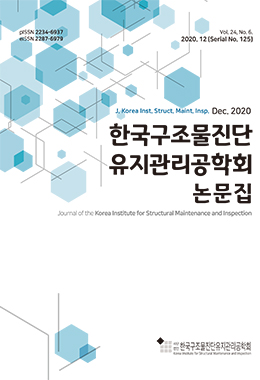철근 콘크리트 구조물에서의 염화물 침투에 따른 구조물의 열화는 주요한 문제로 이와 관련하여 현재까지 많은 연구들이 수행되고 있다. 콘크리트 구조물의 염화물 침투에 있어서 염화물 확산 이외에도 염화물 흡수에 의한 침투도 고려되어야 하며, 구조물의 사용기간 중에 발생되는 균열은 염화물 침투의 주 경로가 될 수 있기 때문에 이러한 변수들이 구조물의 내구성능 평가에 고려되어야 한다. 본 연구에서는 철근 콘크리트에 두 가지 균열 폭 (0.1 mm, 0.3 mm)을 발생 시킨 후, 염화물 흡수 실험을 실시하였다. 염화물 흡수 실험으로부터 흡수에 따른 무게 변화와 AgNO3 용액을 이용한 변색법으로 균열면에서의 염화물 침투 정도를 확인하였다. 변색 범위를 이용한 이미지 분석 또한 실시하였다. 흡수 시간 및 균열 폭이 증가하면 염화물 흡수량이 증가하는 것을 확인 하였다. 모든 균열 폭에서 1 시간 이내에 염화물이 철근 깊이까지 도달하였다. 또한 철근 계면을 통한 염화물 이동 가능성을 확인하였으며, 이는 철근 부식의 주요한 원인으로 작용할 수 있어 추가적인 실험을 통한 검증이 필요할 것으로 판단된다.
Deterioration of reinforced concrete structure caused by chloride ingress is the main issue and regrading this, many studies have been investigated with both experiments and computational modelling. In addition to chloride diffusion, chloride sorption should be considered as a chloride transport mechanism in concrete structure and cracks formed in concrete structures are the main variable to evaluate the performance of the structures. In this study, after making two types of cracks width (0.1 and 0.3 mm) in reinforced concretes, chloride absorption tests were performed. Weight change and colour change using 0.1 AgNO3 solution from the samples were performed to measure chloride ingress. Image processing was also carried out to quantify range of colour change in carck face. From the result, it were confirmed that the amount of chloride absorption increases with exposure time and increasing crack width, and chlorides reached at steel depth within 1 hour. It would be possible that chloride can move through interface bewteen steel and concrete, thereby further study regarding this is required.




